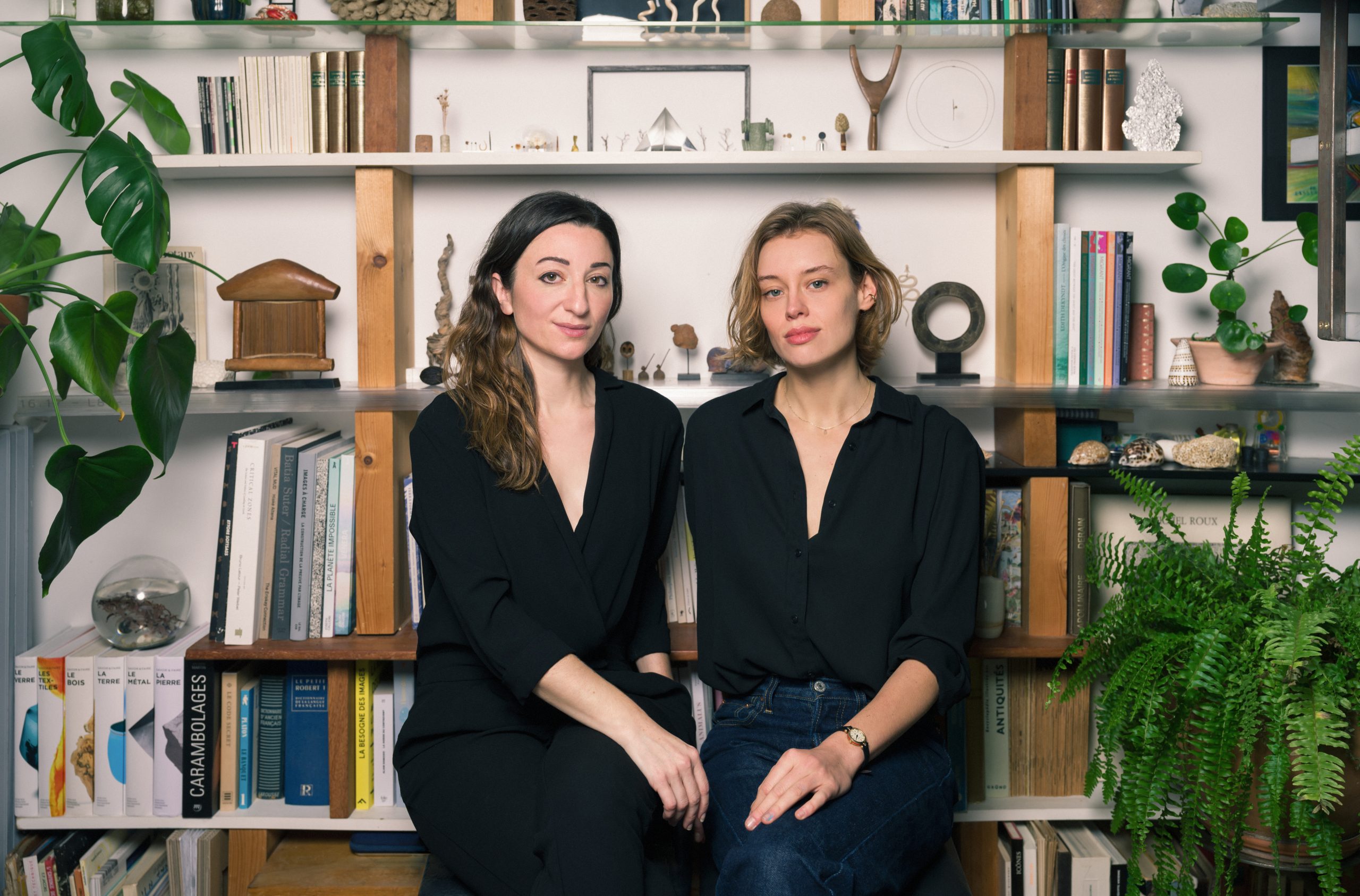Marie-Sarah Adenis & Cyrielle Gulacsy
Multidisciplinary artists
January to March 2025

Michael Huard
- Visual Arts
- San Francisco
“To go from equation to myth and back again. Unearthing forgotten truths. Descend into the arena of the living. Get to know microbes. Kneel before the infinitely small. Hoist tiny lives to Olympus. Forge new founding myths. Shift our imaginations. Incorporate the invisible. Sketch out a new ecology, both scientific and mythological. And give birth to a universal, turbulent and polyphonic cosmogony.”
We have a lot in common. Particularly points. For me (Marie-Sarah), the “point” is the pixel of the living world, the cell, the microbe, the vibratory unit of the web of life. For Cyrielle, the “point” is the pixel of the Universe, the particle, the celestial object; so it’s only natural that she and I should enter the tiny worlds where her dots animate the microbial matrix invoked by the text.
My craft is based on writing, Cyrielle’s on painting. But we’re doing the same thing: giving shape to the infinitely large from the infinitely small. With the same obsession for accumulation and the infernal cadences inherent in the agitation of atoms, the insane speed of grains of light and the exponential proliferation of unicellular organisms.
Changing the way we look at microbes is also an aesthetic challenge that calls for a renewal of forms. Their irruption into our representations of the world has caused such upheaval that a new language had to be invented, one that was both earthly and hybrid, capable of articulating a double narrative of origins, in which the voices of science and myth are heard. But it’s also a graphic challenge, because the immense power and diversity of the microbial world is often reduced, as the microbe emoji shows, to a frightening little ball covered in spines. Cyrielle manages to break out of the trap of figuration to invent a new physicality for microbes.
Telling and seeing the story of living things differently, to bring us into contact with the forces at work – within us and all around us – is the challenge of this book, which invites us to switch to a new system of embodiment and attention.
Marie-Sarah Adenis is a multidisciplinary artist trained in biology (ENS-Ulm) and design (ENSCI). Part visual artist, part researcher and part storyteller, she explores new forms of representation and storytelling to understand the mysteries of the living world. Her projects lay the foundations for a new ecology, both scientific and mythological. After several years devoted to DNA and the creation of a deoxyribonucleic cosmogony, she is now working on the advent of a microbial cosmogony, at the crossroads of microbiology and mythology. Her work has been exhibited at the Palais de Tokyo, the Centre Pompidou and the World Conservation Congress. She is also at the origin of an ecological color bioproduction process, with the biotechnology company Pili, which she co-founded.
Cyrielle Gulacsy is a self-taught artist. Initially driven by a quest for realism, her work evolves under the influence of modern physics, towards the representation of an imperceptible reality. Space-time, electromagnetism and the diffraction of light are all areas of research and experimentation that enable the artist to explore new representations of reality. The forms she employs range from painting to sculpture to photography. Her pointillist approach stems from a desire to get closer to the quintessence of things, and to capture infinite quantities that are difficult to conceive. She is represented by Galerie Anne-Sarah Benichou in Paris and Mignoni Gallery in New York. She has exhibited at the Musée d’Orsay and numerous international institutions and fairs.
“In the beginning were microbes. But nobody knew that. Then the gods took over, and we believed in them for millennia.”
These are the opening words of the book that is the subject of this residency at the Villa Albertine, and which will be published by Actes Sud. This text seeks to produce the outline of a new cosmogony, a new narrative of the world that interweaves science and myth to offer a three-dimensional view of the origins of life. And life is essentially about microbes, which are the oldest, the most numerous and the most diverse. Like gods, they have terraformed the world, established the grammar of life and made themselves essential to every form of life on Earth. Tucked away in microscopic worlds, these demiurges operate like the deities who populate our collective imagination. This book pairs microbial phenomena with myths to explore the mysteries of life from both scientific and dreamlike angles.
The text is fragmentary, reminiscent of an archaeological dig that requires the imagination to operate fully. This is where microbes emerge from between the dots. The drawings, also fragmented and splintered, offer clues to a world that cannot be completely caught. But they extend the words and give substance to the elusive, tracing paths for thought. They recite an unknown score, a song of tracks on the scale of the inframundane.
The book articulates deep time and contemporary issues, constantly moving back and forth between our world and what made it possible. It is peppered with poetic axioms, sometimes leading to new philosophical concepts that are fertile ground for contemporary ecological thinking, which will benefit from greater integration of microbial life, the keystone of ecosystems, the matrix of the living world and an inexhaustible source of fables.
Michelet declared in 1857 in his text L’insecte: “There is a world beneath this world, above, within, all around, of which we have no doubt”. We could repeat word for word what is even more strikingly true of microbes, for we have only glimpsed the little toe of this majestic Leviathan that works on us from within, possessing us and making us possible.
California has opened secret passages to the origins of life with its unique ecosystems, allowing us to travel back in time and study the conditions that led to the emergence of life on Earth. It’s an open-air laboratory, very inspiring for writing and drawing, to traverse ancient forests that rest on primitive chemical cycles, or even arid canyons and deserts that shelter forms of life such as extremophilic microbial communities, which still allow life to thrive.
The book begins here, in the outskirts of the world. It is here, then, that we had to come to write this original surge of inorganic matter, which suddenly extends to give birth to organic worlds. This residency was both an opportunity to be touched by the power of these unusual ecosystems, and to enjoy another vibrant ecosystem, human this time, that of the San Francisco Bay. This literary and scientific investigation was nourished by encounters with biologists working on prebiotic chemistry, and others tracking the first microbial communities that terraformed the world.
In partnership with

Actes Sud
Actes Sud was founded in Arles, France, in 1978. Initially focused on discovering and promoting new international literature, Actes Sud soon evolved into a generalist publishing house, widely recognized for its openness and dedication to environmental issues. Within this context, the Mondes Sauvages collection was launched in 2017 as a unique platform for voices exploring innovative approaches of connecting with all living beings.

Djerassi Resident Artists Program
The mission of the Djerassi Resident Artists Program is to support and enhance the creativity of artists by providing uninterrupted time for work, reflection, and collegial interaction in a setting of great natural beauty, and to preserve the land on which the Program is situated.
Djerassi Resident Artists Program is recognized internationally for its pre-eminence as an artist residency. We strive to provide the best possible residency experience for artists of superior talent from a diverse range of backgrounds and geographical locations.
As stewards of a unique and beautiful property, we also seek to preserve the land and use our facilities wisely and efficiently for maximum benefit to the artists and with the least impact on the environment.

Engie Foundation
Created in 1992, the ENGIE Foundation is dedicated to translating the ENGIE Group’s commitment to social solidarity into action. In line with the Group’s business responses to social and environmental challenges, the Foundation supports innovative philanthropic projects that contribute to build a more harmonious and sustainable future. In particular, its actions are in line with the Group’s ambition to contribute to the Sustainable Development Goals (SDGs). Emergency aid for populations affected by disasters, Children’s Aid and Education, Biodiversity & Climate, Access to Energy, the Fight against Poverty and Social Integration are the Foundation’s top priorities, with a focus on caring for life and our planet, and meeting the needs of vulnerable or remote populations.
Every year, the Foundation supports over a hundred projects worldwide. With almost 50% of its projects dedicated to access to renewable and sustainable energies and to biodiversity by 2024, the ENGIE Foundation is committed to the environment year after year. Supporting high-impact projects, participating in the collective effort of Agenda 2030 and conveying ENGIE’s raison d’être: this is what guides the action of the ENGIE Foundation on a daily basis.
